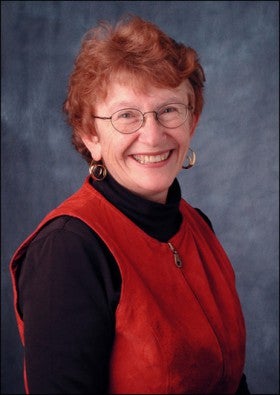Five questions for Jane Menken
The new Institute of Behavioral Science (IBS) building will be dedicated April 28, and its director, Jane Menken, couldn't be happier. Previously, most IBS faculty members were scattered all over the University of Colorado Boulder campus, making it difficult to carry out interdisciplinary, collaborative research concerning societal issues.
To celebrate the new building, a Dedication Symposiumwill bring together a number of distinguished academics to Boulder to discuss "Behavioral Science in the Twenty-First Century: Prospects and Challenges." The event, open to the campus and anyone interested in the future of behavioral science, is set for 8:30 a.m.-4:30 p.m. April 28 in the main conference room at the new building, 1440 15th St., at the corner of Grandview Avenue.
Currently, there are five programs and several centers within the institute whose mission it is to translate research into policy and practice. These programs and centers are: health and society; institutions; environment and society; problem behavior; population, Menken's main research home; the Center for the Study and Prevention of Violence; and the Natural Hazards Center.
Menken arrived at CU in 1997 as a professor of sociology and a faculty associate at the IBS, which was established in 1957. She became director in 2001. She provides support for the faculty, especially when it comes to finding funding for research projects. She also acts as liaison with upper administration and works with the other departments – such as anthropology, psychology and political science – where faculty members are housed.
And she finds time for her own research endeavors. Her undergraduate degree in mathematics and a master's in biostatistics were a good base for an opportunity at the Harvard School of Public Health to work with people whose research was on population. The research, on maternal and child health and family planning in South Asia, led to an interest in fertility and a fundamental question of why lifetime fertility varied widely in populations that did not practice deliberate fertility control.
During time off, she likes to put population and statistics out of her mind and appreciate the world. She and her husband have biked across Italy and France. "It's wonderful to be able to take a week or 10 days, and have nothing to do but get on your bike," she says.
— Cynthia Pasquale
1. The IBS is moving into a new space – an inside/outside building – making it the first time in 40 years the entire faculty and staff will be under one roof. Why is this so important?
The programs were in different buildings – some separated by more than a mile. All the faculty members have two homes, one in IBS and one in a disciplinary department. My hope is that better research and innovative research will come out of it.
The building is called inside/outside because it is important to have light and communication with the outdoors while at work. We used glass in doors, skylights, clerestory windows inside offices, terraces on each floor and sitting areas with views of the outdoors.
We believe it is important to be able to take a few seconds from work to appreciate the world around us – and in Boulder, that's a beautiful world. This kind of building encourages connections among the people working in it – and, we believe, benefits us and benefits our work.
2. Population growth has profoundly affected the world in many ways over the years. What types of problems or benefits do you foresee in the future should the world's population continue to grow?
There's a wonderful book by Joel Cohen titled, "How Many People Can the World Support?" He points out that the answer depends on the standard of living for each person. Africa, for example, is much less densely populated than the rest of the world. All the population of Africa could move to one country, the Sudan, which would be less densely populated than the United States is today. Bangladesh, by contrast, has a population about one-third the size of the U.S. population, but is squeezed into an area the size of Wisconsin. So the question has to do with how we live.
Europe, by contrast, is decreasing in population because it has such low fertility. So there are problems associated with growing rapidly and with growing slowly. I focus more on determinants of population growth and on the composition and health and economic opportunity of populations. For example, Europe is faced with aging populations and the problems of immigration, whereas Africa is faced with outmigration of skilled people, a recent sharp rise in communicable diseases (AIDS and tuberculosis) and, at the same time, a rise in noncommunicable diseases (heart disease and stroke, diabetes).
3. What have you accomplished with your work in Africa?
The work in Africa has two parts – research and capacity building. We work with two institutions, the University of the Witwatersrand in Johannesburg, South Africa, and the African Population and Health Research Center. We have been instrumental in helping develop graduate programs in population sciences at Wits and in supporting postdoctoral fellows at APHRC. The work at Wits has provided opportunities for U.S. postdoctoral fellows to teach and carry out research in Africa and for CU grad students to participate. So the benefit goes both ways. We hope we're developing increased capacity in U.S. institutions for work on and in Africa.
Our research thus far has focused on HIV/AIDS – both estimating the prevalence of AIDS and on understanding the ways in which communities, households, families and individuals are affected by and cope with AIDS. We are also looking at the rising rates of noncommunicable diseases.
4. What is your most interesting work to date?
What's been most interesting has changed over the course of my career. Earlier, it was the mathematical models that promoted understanding of fertility and fertility change. That led to a strong interest in status of women and women's health, primarily working in Bangladesh. Now my interests go in two directions: AIDS and its impacts and the longer-term effects of intervention through programs like maternal and child health and family planning.
For instance, in Bangladesh, we're looking at whether families that chose to have smaller numbers of children actually have children who are better off in their adulthood.
There's 40 years of information that has been collected regularly in Bangladesh. We are planning to trace out families, some of whom could have taken advantage of the family planning program and some who live in areas where it was not offered. We're asking if people who had fewer children were able to give them greater opportunity, and whether the children were better off in terms of education. We're also asking whether parents were better or worse off. In other words, for parents who had fewer children, were those children better able to support their parents in old age.
The other question would be what is the impact on status of women? Were girls given more opportunity and are they valuable?
5. The Dedication Symposium will focus on the challenges of behavioral science in this century. What do you see as the biggest challenge?
There are multiple big challenges: One is the disparity in income and resources between the developing world and the developed world. A second is the disparity in health between those who are well off and those who are not. Prospects for handling all of these challenges have to do with knowledge of the problems as well as technical inputs. Improvements in medical findings are clearly important, but understanding how people live in the environment and how problems are handled or not handled will play a role in how that disparity is reduced.



